‘Bharat’ the great land of great Sailors
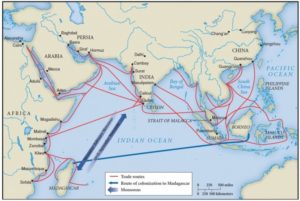 A ship with three masts in full sails found in cave No. 1 is one of the best and most detailed representations of a sailing ship in Bharatiya art. The boat has a pillared cabin in the middle. To the left of this ship is shown a sinking ship whose only one end is visible above the water. The crew of the ill-fated ship has jumped into the water and was struggling to survive. An episode from Avadanasataka is painted in cave No. 2. The ship has three masts with rectangular sails, bowsprit (projecting from the ships prow) and a jib sail (triangular sail rigged to a stay supporting the mast extending from the foremast), suggesting that it is sailing in the sea. There is another mural in the Cave No. 17 depicting two small boats with three masts. Two men holding ropes suggest some sort of diving in the sea. Some men may be seen in the wrecked boats. The hull of the ship resembles a bowl or a basket, and the bottom is slightly curvilinear. These boats were suitable for use in lagoons and near coral reefs. In one of the boats, there are two men, one holding in his hands a box tied with a string, evidently containing jewels (ratna), which they seem to have retrieved from the sea (Ratnakar).
A ship with three masts in full sails found in cave No. 1 is one of the best and most detailed representations of a sailing ship in Bharatiya art. The boat has a pillared cabin in the middle. To the left of this ship is shown a sinking ship whose only one end is visible above the water. The crew of the ill-fated ship has jumped into the water and was struggling to survive. An episode from Avadanasataka is painted in cave No. 2. The ship has three masts with rectangular sails, bowsprit (projecting from the ships prow) and a jib sail (triangular sail rigged to a stay supporting the mast extending from the foremast), suggesting that it is sailing in the sea. There is another mural in the Cave No. 17 depicting two small boats with three masts. Two men holding ropes suggest some sort of diving in the sea. Some men may be seen in the wrecked boats. The hull of the ship resembles a bowl or a basket, and the bottom is slightly curvilinear. These boats were suitable for use in lagoons and near coral reefs. In one of the boats, there are two men, one holding in his hands a box tied with a string, evidently containing jewels (ratna), which they seem to have retrieved from the sea (Ratnakar).
South East Asia

An inscription found at a place about two kilometers from Pagan, reads :
Nastha dharme na vasu-nicaye naiva kamopabhoge,
Yad-yad bhavyam bhavatu bhagavan purva-karmanurupam,
Etat prarthyam mama bahu matam janma-janmaanre’pi,
Tvat-padambhoruha-yuga-gata niscala bhaktirastu
नास्था धर्मे न वसुनिचये नैव कामोपभोगे,
यद् यद्भाव्यं भवतु भगवन् पूर्वकर्मानुरूपम् |
एतत् प्रार्थ्यं मम बहुमतं जन्मान्तरेsपि,
त्वत्वादाम्भो सहयुगगता निश्चल भक्तिरस्तु ||
“O my lord! I have no attachment for religiosity, or for accumulating wealth, or for enjoying sense gratification. Let these come as they inevitably must, in accordance with my past deeds. But I do pray for this most cherished boon: birth after birth, let me render unflinching devotional service unto thy two lotus feet.”
This is a prayer from the Mukundamala of Kulashekhar Alwar of Kerala (Sutra 5), a well-known saint and poet of those times. In Kaliyugabda 4402 (CE 1300), a great temple he got the sabhamandap rebuild. He constructed a door and arranged for the daily worship of the deity and lighting lamps regularly. He created a corpus fund out of the interest of which expenses of worship of the deity were to be provided for. This trader has kept his memory alive by having this inscription written on a stele for the posterity.
An inscription about Champa Naresh Prakash Dharma of Shakabd 579 (757 CE) was found in Sanskrit in Myson (central Vietnam). This inscription states that Shailaraj Koundinya and Soma, the queen of the Nagas, got married and estanlished the kingdom.

(Tatra) sthapitvan shulam Kaundinyastaddwijarshabhah |
Ashvatthamo dwijshreshad dronputradavapya tam ||
Kulasid bhujagendra kanya, Someti sa vanshakari prithivyam |
Ashrityabhavetivisheshavastu, ya manushavasamuvasa… ||
Kaundinyanamna dwijapungaven karyarthapatnitwamanayi yami |
Bhavishyatorthasya nimittabhave vidherachintyam khalu cheshtitam hi ||
(तत्र) स्थापितवान् शूलं कौंडिन्यस्तद्द्विजर्षभ: |
अश्वत्थामो द्विजश्रेष्ठाद् द्रोणपुत्रादवाप्य तं…||
…कुलासीद् भुजगेन्द्र कन्या, सोमेति सा वंशकरी पृथिव्यां |
आश्रित्यभावेतिविशेषवस्तु, या मानुषावासमुवास… ||
कौण्दिन्यमाम्ना द्विजपुड्.गवेन कार्यार्थपत्नीत्वमनायि यामि |
भविष्यतोर्थस्य निमित्तभावे विधेरचिन्त्यं खलु चेष्टितं हि ||
“Ashwatthama, the son of Dronacharya, had gifted Koundinya with an enchanted spear. Koundinya swung the spear around and threw it with great force. He established his Capital at the place where this spear landed on the ground. The great Brahmin King Koundinya married Queen Soma of the Nagas. This was the divine will to establish this Kingdom.”
Capital of this kingdom was named Vyadhapur. King Koundinya civilized the people. He taught them reading and writing and acquainted them with many other fundamental traits of civilized living. The Bharatiya Dharma and ethos propounded in the Manu Smriti were introduced.
There are two main sources for the history of Cambodia of this period. The first is archaeological source and the other is Chinese history. A large number of inscriptions have been found in south-east Asian region. Chinese historians have recorded history of all the southeastern countries and preserved it for the posterity. The kingdom founded by Koundinya finds mention in the history of China. “The Funan Empire” is the name given to this kingdom by these historians. According to Chinese historians hundreds of worriers from Bharata came in the wake of Koundinya. They adapted themselves to the lifestyle of the local people and married the Naga damsels. Vyadhapur was about 150 KM away from the sea shore. Kambuj Desh had a peculiar weather. Rainfall in the region was abundant. But after the downpour the land became dry. Koundinya prepared projects for storing of the rain water, by constructing small and big dams. Archaeological excavations prove that a network of canals was created in the region. Remains of extensive canal system of this period spanning the area between Vyadhpur and Oc Eo port in the Mekong delta have been found by the French archaeologists. These irrigation works helped in the advancement of agriculture and the country became prosperous.
Rama Khameng – Kaliyugabda 4385 (1283 CE)
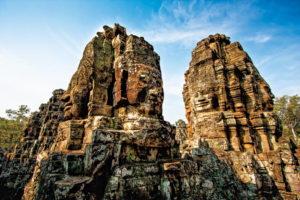
Rama Khameng ascended the throne after the death of his father and uncle. He turned his small and struggling kingdom into a powerful Thai state. When he became the ruler, Sukhodaya was a tiny state, only a few hundred square miles in expanse. He succeeded in his efforts through shrewd diplomacy and successful military campaigns to expand it. In about two decades the empire stretched from Laos in the east to the Bay of Bengal in Myanmar and to Malay Peninsula in the south. Rama Khameng ruled through local rulers who regarded him the sovereign. There was all-round development in the country during his regime.
An inscription on the stele of Rama Khameng composed in Kaliyugabda 4394 (CE 1292) gives us interesting information about his brilliant carrier. He himself says “My father was named Indraditya; my mother was namned Naga Sung We were five children born of our parents – three boys and two girls. When I had grown and reached the age of nineteen, Khun Sam Chon, chif of Muang Chot came to attack the country. My father went to fight him from the left. Khun Sam Chon came from the right and made a powerful attack. My father’s people fled and dispersed in complete disorder. I did not flee. I mounted the elephant ‘Aneka-bala’ (immense power) and drove it in front of my father. I had duel with Khun Sam Chon riding an elephant. I smote his elephant named ‘Mat Muang’ (gold of the country) and made Khun Sam Chon flee the battle field. Then my father gave me the name ‘Phra Rama Khameng’ (Rama, the strong). During the lifetime of my father, I served him… When my father died I continued to serve my elder brother as I had served my father. When my brother died the whole kingdom passed on to me.”
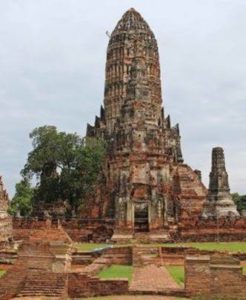 It was Shrutavarma who laid the foundation of a royal dynasty. His son Shreshthavarma ascended the throne in about kaliyugabda 3536 (CE 434). It was a new kingdom, bordering the powerful Funan Empire. Bassak or Champasaka, on the border of Cambodia, was the seat of the kingdom. Shreshthavarma captured it from the Cham king Devanika. To commemorate his conquest Shreshthavarma established a sacred shrine on the Linga Parwat where a Shiva Linga was installed. The Shrine was designated as Sri Bhadreshwar.
It was Shrutavarma who laid the foundation of a royal dynasty. His son Shreshthavarma ascended the throne in about kaliyugabda 3536 (CE 434). It was a new kingdom, bordering the powerful Funan Empire. Bassak or Champasaka, on the border of Cambodia, was the seat of the kingdom. Shreshthavarma captured it from the Cham king Devanika. To commemorate his conquest Shreshthavarma established a sacred shrine on the Linga Parwat where a Shiva Linga was installed. The Shrine was designated as Sri Bhadreshwar.
History records that the Chinese invaded Champa kingdom and its Hindu Devanika ruler could not cope with them. He is said to have assembled his troubled people, and they all began their pilgrimage in search of Lord Shiva. After several weeks of tiring journey, they arrived at the base of a tall mountain. They named it Linga Parwat. They reached Champasak province in southern Laos and built a city called New Kurukshetra around mid fifth century CE. South east Asia’s oldest Sanskrit inscription informs of a city named Kurukshetra which was founded by a King Devanika and was the capital of the Mon-Chenla kingdom.

An inscription about Prithvindra Varma reads :
Shirman narendrah Prithvindravarma|
Khyaptaswa vamshairjagati prabhavaih ||
Hyastitiloke sa bhunakti bhumim |
Shaktyacha nirjjitya ripun hi sarvan ||
“श्रीमान् नरेन्द्र: पृथिवीन्द्रवर्मा
ख्याप्तस्स्व वंशैर्ज्जगति प्रभावै: |
ह्यस्तीति लोके स भुनक्ति भूमिं
शक्त्याच निर्ज्जित्य रिपून् हि सर्वान् || “
Pandurang Dynasty was founded after Rudravarma by Prithvindra Varma in 757 CE. On the death of Prithvindra Varma his sister’s son Satya Varma became ruler in CE 774. The same year the Shalendras from Java disembarked in Kauthara, burned the temple of Po Nagar, and carried off the image of Shiva. Tha Cham king Satyavarman pursued the raiders and defeated them in naval battle. In CE 781 Satyavarman erected a stele at Po Nagar (Shiv temple), declaring that he had regained control of the area and resorted the temple. In CE 787, Japanese raiders destroyed a temple dedicated to Shiva near Panduranga. After Rudravarma, a powerful ruling dynasty took over in the south of Champa, in Panduurang (present phanarang). The dynasty is named after its seats of Power.
“Prithvindra Varma defeated his enemies by his own prowess and obtained the kingdom of champa. His kingdom was overflowing with riches, food and all sorts of resources.”
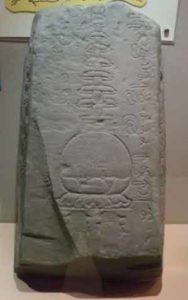
The mariners who left Tamralipti and sailed across the Bay of Bengal needed an anchorage and resting place. Merbok in Kedah was an ideal place for these purposes. Close to the town was the Kedah peak which served as a landmark for the sailors. The terrain in the foot hill was a good place for settlement and here developed the first Bharatiya settlement of Malayan peninsula along the banks of the Bujang. Remains of a large number of jetties have been unearthed by the river side in the vally. For these first settlers the mountain became the abode of Gods. Shivlingams abound in mountains in such a large number that the Bujang valley has come to be called the vally of Shivlingams.
According to another tradition, in Kaliyugabada 37th Century (5th Century CE) the kings of Langkasuka became weak. One of the Sons of a king was very intelligent and was possessed of high character. The king determined that the prince would be in trouble if he remains in the kingdom. Therefore, he sent him away to Bharata. The prince married a Bharatiya Princess. After the demise of king of Malaya, this prince was called back to Malaya. He accordingly, returned and ascended the throne of Malaya. His son Bhagadutta took over as king after him. Bhagadutta made contact with China in 511 CE and sent several embassies to the Chinese Emperor. The records of king of the Liang dynasty of China give description about this king and his kingdom.
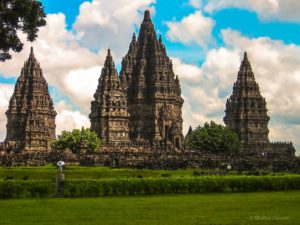
Shriman data kritagnyo narapatirasamo yah pura Tarumayat |
Namna shri Purnavarma prachur ripusharabhedya vikhyatvarma ||
“श्रीमान् दाता कृतज्ञो नरपतिरसमो य: पुरा तारुमायात् |
नाम्ना श्रीपूर्णवर्म्मा प्रचुर रिपुशराभेद्य विख्यातवर्म्मा || “
Tasyedam padabimbadvayamarinagarotasadane nityadksham |
Bhaktanam yannripanam bhavati sukhakaram shalyabhutam ripunam ||
तस्येदं पादबिम्बद्वयमरिनगरोत्सादने नित्यदक्षम् |
भक्तानाम् यन्नृपाणाम् भवति सुखकरं शल्यभूतं रिपूणाम् ||
Three Inscriptions of Kaliyuabada 36th Century (5th Century CE) of Poornavarma found in western Java at Ciaruteun (near Ciaruteun river) Jambu and Kabon Kopi, near the town of Batavia on the west coast of Java, give information of the influence of Bharata on Java. According to Tugu inscription found in Tugu village, of Jakarta province, Purnavarman built a canal that changed the course of the Cakung Lama River, and irrigated coastal region. In his inscriptions, Purnavarman associated himself with Vishnu. Prasasti Jambu informs that Poornavarma was a very powerful king He was extremely charitable.
At this time, the pouranic Hindu Dharma was prevalent in Tarum kingdom. Poornavarma was a devotee of Sri Vishnu. This was a tradition to think of the king as an incarnation of Sri Vishnu on the earth. The footprints of Poornavarma were inscribed in stone, which have been said to be Padadwaya or the scared feet of Sri Vishnu. These footprints were said to be sufficient to scare the opponents and to give a sense of safety to friendly kings.
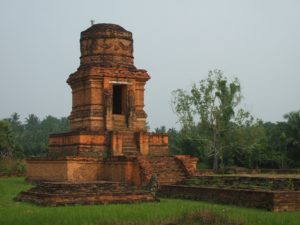
Sri Vijay was an important trade center of South East Asia. About 1300 years ago. Sri Vijay the capital was the very prosperous city and important center of world trade. The entrance gate to the City was covered with sheets of gold. The neelmani gems (turquoise) embedded in the pillars of the entrance of the city where full of effulgence. On both sides of this broad boulevard lined two or three storied mansions. There was a seven storied mansion standing majestically in the middle of the city.
Whenever any important personage from Bharata came here, the people welcomed him with great enthusiasm. Acharya Dharmapal, the Chancellor of the Nalanda University of Bharata, visited Sri Vijay sometimes in the 8th century CE for a short period. This was a great occasion when a great spiritual leader visited a great Emperor who was the protector of Dharma. Such relations subsisted between the scholars and spiritual leaders of Bharata and the king of South East Asia.
The city was at the center of the international Sea routes and had trade relations with Bharata in the west and through Bharata with Greece, Middle East, Rome, Egypt and other parts of the World. China, Japan and Korea were connected with Sumatra through sea routes. Buddhism had become dominant faith in the Eastern world by this time. All sacred places related to Lord Buddha were in Bharata. The universities imparting education in the sacred text of Buddhism were also located in Bharata. Bharata was therefore the sacred land for the Buddhists. Buddha Bhikshus visited Bharata for pilgrimage. The famous Chinese traveler I-Tisang’ (635-713CE) left China for Bharata towards the end of the Kaliyugabda 38th Century (7th Century CE). He reached Sri Vijaya after a journey of 22 days by sea where he spent the next six months learning Sanskrit grammar as knowledge of Sanskrit was essential for seeking admission in Nalanda University. The written records of his 25 years travels contributed to the work knowledge of the ancient kingdom of Sri Vijaya as well as providing information about the other kingdoms lying on the route between China and the Nalanda Buddhist University in India. He stayed at Nalanda for 11 years. He was all praise for the high level of Buddhist Scholarship in Sri Vijaya and advised Chinese monks to study there prior to making the journey to Nalanda in India. On his way back to China in the year 687, he stopped in the kingdom of Sri Vijaya for eight years till 695 CE. Here he translated many original Sanskrit Buddhist scriptures in to the Chinese.
East Asia
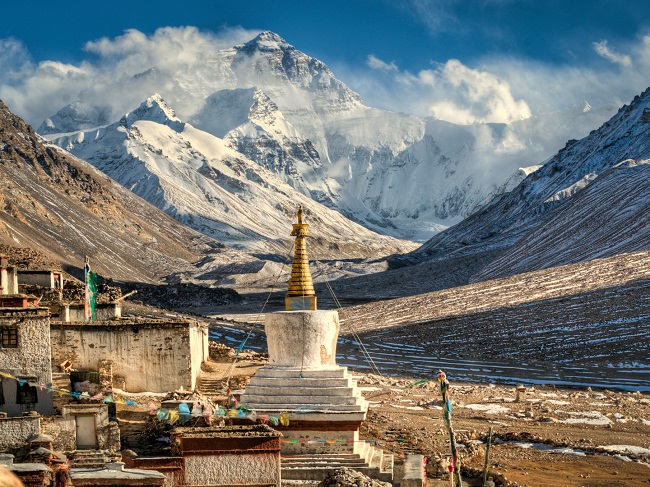
Tibet was one of the earliest regions where Buddhist monks reached. Tibet is a vast plateau. Its area is about 12,80,000 Sq Kms. It is about 16000 to 18000 feet above the sea level. Manasa Sarowar and Rakshagatal, both these sacred lakes are within the borders of Tibet, Kashmir, China, Nepal, Sikkim and Bhutan have their borders contiguous with it. Rivers Yangzi and Hwang Ho of China originate from here. Rivers Brahmaputra, Sindhu, Shatadru (Sutlej) and Karnali also flows from Tibet. Lhasa the capital of Tibet is situated on the banks of the River Kyi Chu a tributary of the Brahmaputra (Yarlung Tsangpo).
The first dynasty of Tibet was established by an exiled king of Magadh in Kaliyugabda 2975 (17 B CE). This Magadhan king construed the first fort in Tibet at Yumbu, known as Yumbu Lagar. The first kingdom in Tibet was founded in the Yarlang region. Buddhism was introduced for the first time in Yugabd 325 (173 CE) during the region of king Lha Thothori Nyantsen. It was gradually disseminated and integrated into the Tibetan way of life due initially to the efforts of the religious kings.
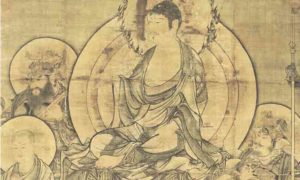
According to on story, a group of Buddhists priests arrived in Kaliyugabda 2885 (217 BCE) at the capital of Qin Shi Huang in Xianyang. Han Wudi (141-86 BCE) the 5th king of Han dynasty received the golden image of Buddha from Central Asia. It was brought to him by a Chinese general who led an expedition to Central Asia in Kaliyugabda 2981 (12 BCE). Hon Hanshu the official Chinese historical book compiled in Yugabd 36th century (5th Century CE) also mentions propagation of Buddhist Sutras by the Central Asian people during this period.
It was in Kaliyugbda 3127 (25 CE) that Han Emperor Ming saw a golden figure 16 feet tall in his dream. To assuage his curiosity regarding this dream his minister told him that it corresponded with the prophesy made about 1000 years ago regarding the teachings of a great saint from the west of China. The emperor then dispatched 12 officials to the west who eventually came across two Bharatiya Boddhisatvas Kashyap Matang and Dharmarakshit. They agreed to go to China with them. They returned to the Han capital Loyang with a picture of Shakya Muni Buddha and some sutras laden on a white horse. Both the monks, Kashyapa Matang and Dharmarakshit, were highly respected by the Emperor and the people. A monastery, was erected at Loyang the capital of the Han rulers in their memory as the monks had brought a huge load of sacred text on the back of a white horse. Here they started to translate the sutras in a temple, later called White Horse Temple (Shwetashwa Vihar). They translated five sutras. It was the first time that Buddhism was recognized by the Chinese government as an official religion. In this manner Buddhism began to build up its foundation and organization in China. This was the first Vihara in China. A university was started there in order to impart education in the fine Arts, Sciences and Buddhism. Matang Rishi had taught the four principles of Buddhism, namely, friendship, compassion, happiness and indifference (maitri, karuna, mudit, upeksha) towards people with different attributes. Rishi Matang also carried out the first compilation in Chinese of the Buddhist philosophy.
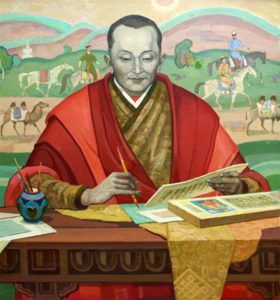
First wave of Buddhism in Mongolia began in the third Century BCE, three centuries before Buddhism took root in China, during the period of Emperor Ashoka. Traditionally Mongolians recognize their 2nd Highest Lama Jaya Pundita (1599-1662 CE) an incarnation of Emperor Ashoka. Cave paintings along the Hor section of the Silk Road bear witness to an early Mongol enthusiasm for Buddhism.
Buddhism was introduced again in Mongolia in Yugabd 3139 (37 CE) from China. Images of Brahma, Saraswati, Ganesh, Mahakal and Bhairava etc were taken by the Buddhists with them. Acharya Abhayankar Gupta of Vikramshila University, born in Gaur, West Bengal, in Eastern India, (late 11th early century CE), popularized Tantrik Buddhism in Tibet and Mongolia. Another Acharya Uduragasen of Bharata popularized the use of the Nepalese Swayambhu script (the one that has grown without conscious efforts). Acharya Matidhwaja of Bharata moulded the language of Mongolia to suit this script. The same script and language are begin used in Mongolia even in present times.
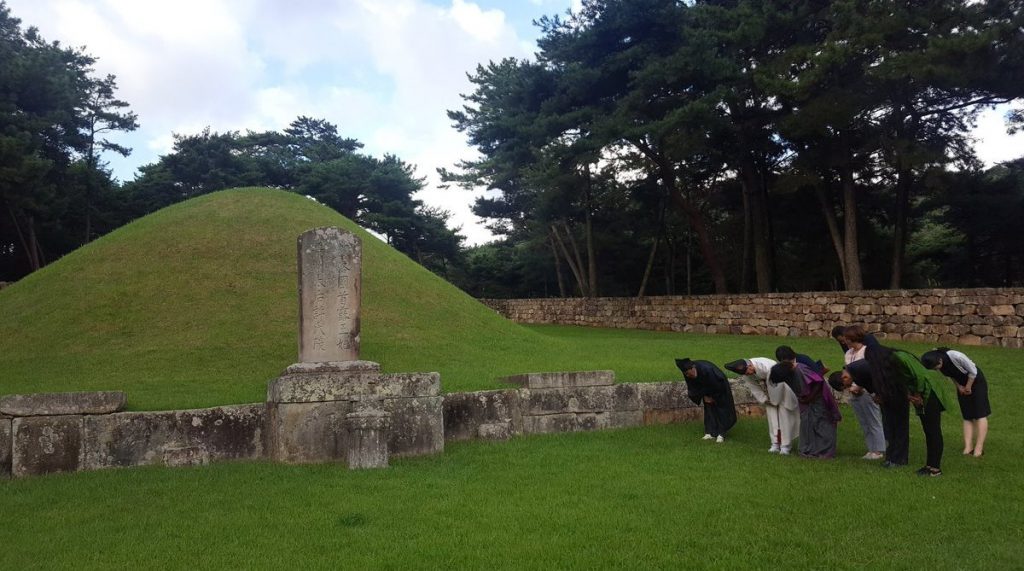
In kaliyugabda 3150 (48 CE), a large ship sporting several flags and red sails aloft entered Geochilsan-guk (Port Busan) at the mouth of the River Nakdong in the south of South Korea. The fort of the capital of Korea was on the banks of River. The Ship came near the fort and dropped anchor. The ship and its crew belonged to the Princess of Ayodhya.
Korean tradition related in Samguk Yusa informs that Heo Hwang-ok was a princess who is believed to have travelled from the ancient kingdom of ‘Ayodhya’ to Korea. Information about her comes from a few passages in the Samguk Yusa (a collection of legends, folktales and historical accounts relating to the Three Kingdoms of Korea), an 11th century Korean chronicle.
According to chronicle, she arrived on a boat and married King Kim Suro of the Korean Gaya kingdom. She is considered an ancestor by several Korean lineages.
Immediately a well decorated ship advanced to welcome this ship. Eight of his chieftains were sent by King Suro to welcome the guest. The princess asked the hosts as to how did they know of her arrival. The leader of the group said that the king was expecting her for quite some time. The king believed that divine forces that made him the king would also bring him a Queen best suited for the Kingdom. He had dreamt of her arrival. He said that they were on the lookout for her ship from the height of the mountain. Observers informed the King the moment they noticed the Ship with bright red sails. The princess was 16 years old and her brother accompanied her.
The Princess said she was happy at the welcome. But she refused to accompany the Chieftains, as they were strangers to her. At this, the King thinking that she must be a great princess and therefore had to be received with full honors ordered for a gorgeous tent to be put up at the south of the fort at the earliest. The Princess started moving towards the fort in procession along with some of her trusted assistants and their wives. After reaching near the camp, she took a bath with holy water with the chanting of mantras and offered silken dress to the Mother Earth. They met the Princess there.
 Seven gods, called the seven gods of Fortune, are popular in Japan, Daikoku-ten evolved from the Hindu deity, Shiva. There is a temple of Mahakal in Tokyo called Mimeguri. The name Daikoku-ten is the Japanese equivalent of Mahakala, one of the names of Shiva. It is the god of great Darkness. Bishamon-ten (Vessavana) also called Bishamon is Vaishravan Kuber. It is the god of worries and guards (Kshetrapal), as well as the punisher of criminals. Benzaiten is the Japanese name of the Hindu goddess Saraswati. Its worship was introduced through the Chinese translations of the Sutra of Golden Light.
Seven gods, called the seven gods of Fortune, are popular in Japan, Daikoku-ten evolved from the Hindu deity, Shiva. There is a temple of Mahakal in Tokyo called Mimeguri. The name Daikoku-ten is the Japanese equivalent of Mahakala, one of the names of Shiva. It is the god of great Darkness. Bishamon-ten (Vessavana) also called Bishamon is Vaishravan Kuber. It is the god of worries and guards (Kshetrapal), as well as the punisher of criminals. Benzaiten is the Japanese name of the Hindu goddess Saraswati. Its worship was introduced through the Chinese translations of the Sutra of Golden Light.
Ganeshji one of the most popular deities has many names. He is known as Shoten, Daishokangiten, Kangiten Ganabachi (Ganapati) Binayakaten (Vinayaka) etc. Hotei is the Laughing Buddha, Fukurokuju is the god of wisdom and longevity and said to be an incarnation of the southern Polestar (Dhruva). Ebishu is the Japanese god of fishermen, luck, and workingmen, as well as the guardian of the health of small children. He is the only one of the seven gods that did not originate from Bharata. The Japanese also maintain the symbol of Mahakala as a monogram. Fudo or Achala (one of the Bodhisattavas) became an idol of worship and got installed as the gohozon or main deity at temples and outdoor shrines. Achala or Achalnath is considered destroyer of the evil and protector of the virtuous. It represents Akshobhya i.e. Ashutosh (God Shiva easy to please). Koyasan became the Kashi of Japan because of its temples and being a principal center of Buddhist learning. Goddess Kishirmojin is the goddess Haritidevi (etymologically derived from Saraswati to Harakhvati to Harawati to Hariti).
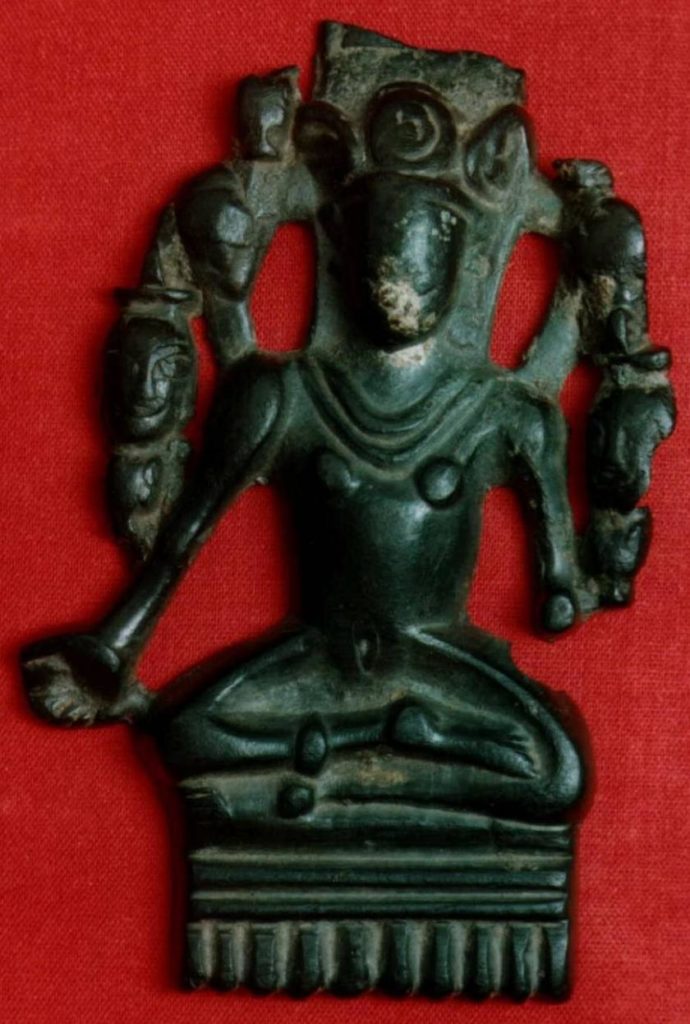
Signatures of past contact of Russia with Bharata are to be found in archaeological remains unearthed in Staraya Maina village, an ancient abandoned village in Ulyanovsk region in the Volga region. The idol of Vishnu dated between the 7th and 10th centuries has been found here. Prior to this discovery, ancient coins, pendants, rings and weapon fragments were unearthed at this place. This village is the site of a densely populated city belonging approximately to third century CE in the Middle-Volga region of Russia. This region was the cultural center of Ancient Russia.
There is evidence of uninterrupted trade between Bharata and Russia since 28th Century of Kaliyugabda (3rd century CE). The Slavs of Russia were influenced by the culture of Bharata. Many significant words in Russian language seem to have derived from Sanskrit. For example videt and znat of the Russian have derived from root words vid and jnya of the Sanskrit. Petronymic suffix which is synonymous with vatsa of Sanskrit. Vata is found suffixed among the Rajputs and many other castes as patronymic even in present times. Brat and Maht are the words for brother and mother. Dva, three, chetireh, pyat, shest, sem, vosem (compare Sanskrit vasu), devyat amd desyat are the words for the numerals from two to ten respectively. System for numeral after ten followed is the same as followed in Sanskrit numerals- for example there are dvenstat and treenstat for twelve and thirteen respectively. The name of Russia compares well with Rishiya and Siberia with Shivira. The people of Siberia call it Shivira and not Siberia. Siberia is a vast terrain measuring more than 350,000 Sq Kms. The tribe of Buryat lives mainly in and around the Baikal Lake. This tribe is most powerful among the people of Siberia.
It was only in the second half of 10th century CE that the Russians accepted Christianity and all other religious practices were prohibited. After this, Russia was culturally cut off from Bharata even though trade link was not completely snapped.
Middle East

Ma vo rasa anitabha kubhakrumurna vah sindhumiriramat |
Ma vah parishthat sarayuh purishinya sme it sunnamastuvah ||
मा वे रसा अनितभा कुभा क्रुमुर्मा व: सिन्धुर्निरीरमत् |
मा व: परिष्ठात् सरयु: पुरीषिण्य स्मे इत् सुन्नमस्तुव: ||
Along with the great river Sindhu, five rivers of Afghanistan are mentioned in the Rig-Veda. Of these rivers, Rasa (Legman), Anitabha, Kubha (Kabul) and Krumu (Kurram) are in Afghanistan. Besides, the rivers Susartu (Sir-Darya), Sveti (Darya-i-safed) and Trishtom also find mention in the Rig Veda, which also belong to Afghanistan.
The northwest border of Bharata extended beyond the Hindukush and reached up to Iran, in the Vedic period. Many Bharatiya tribes lived in the regions beyond the Hindu Kush. There is mention of a bitter war known as Dasharajnya War in the Rig Veda. Though many kings took part in the war, ten kings were the most prominent and for this reason it was known as Dasharagya War. Perhaps this was the first Great War in the known history of the World. This war was fought on the banks of the River Yamuna and Parushni. Sudasa Pajiavana took help of Kings Tutsu, Bharata, Parashu and Prithu and defeated kings belonged to the five tribes (Panch Janas) mentioned in the Rig Veda; and these tribes are living at present in Afghanistan.
“Indra who savours Soma (a drink) freed herd of cows of the Aryas from the Tritsu, At this Pakhta, Bhalanas, Alin, Vishanin and Shiva tribes surrendered to him and started to praise him.”
A pakthaso bhalanaso bhananta alinaso vishaninahshivasah |
A yonayat sadhama aryasya gavya tritsubhyo ajagan yudha nrina ||
आ पक्थासो भलानसो भनन्ता अलिनासो विषणिन: शिवास: |
आ योsनयत् सधमा आर्यस्य गव्या तृत्सुभ्यो अजगन् युधा नृन् ||
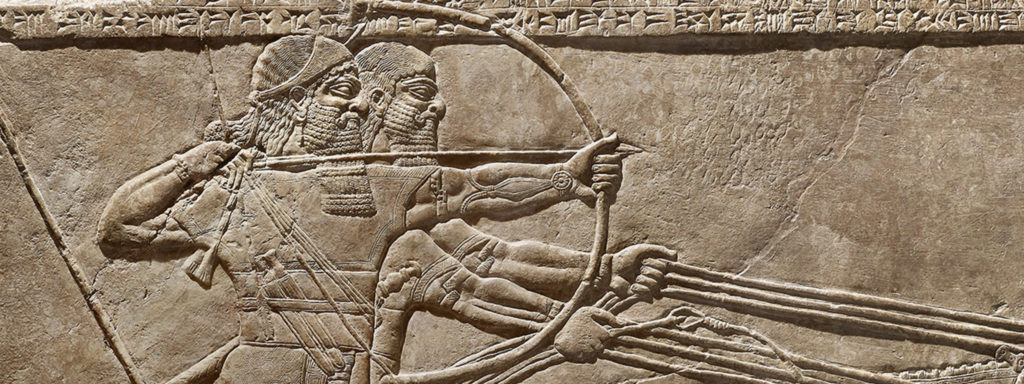
There were two branches of the dynasty of Swayambhu Manu. One was Priyavrata Shakha (Branch) and the other Uttanapada. Five Manus along with Swayambhu Manu and 35 kings belonged to Priyavrata branch. Uttanapada, which had Chakshus Manu. Prajapati etc belonged to Uttanapada branch. Chakshus Manu had ten sons. Five of them civilized central and western Asia. The Puranas do not provide details of all these kings. But the names found in Pauranik literature, the local folklore and some archeological finds establish historicity of these kingdoms. Atyarati or Atiratra, Abhimanyu, Uru, Pur and Taporata established their kingdoms in present Iran. They have been called “Asamudra Kshiteesh” in Aittareya Brahmanas. In the west, their rule extended up to the Adriatic sea (Ardra Sagar).
Susha was the capital of Abhimanyu. It was called Manyupuri, the City of Memnon in the Odissy. In this manner the history of Susha, capital of Elam, goes back to the Vedic period. Herodotus calls Susha the city of Memnon. The remains of Susha are the oldest among the archeological finds in this region. These remains belong to the middle of third millennium BCE. Iran, Iraq, Turkestan and Syria were one cultural and social unit at this time. Certain trading communities grew into powerful kingdoms at various places in this region. Perhaps Uru, brother of Abhimanyu, went to the southwest of Elam and built a city in the valley of Farat and named it Ur Nagar. This place became center of power of the Babylonian Empire. Archaeological remains testify that Ur Nagar had close contact with Bharata. Seals found here are similar to those found in Sindhu-Saraswati i.e. Vedic civilization. Remains of a large temple of Chandra devta Nanna (Moon) have also been found here. The foundation and plinth of this temple was about 210 ft. by 150 ft. The idol of moon was installed on a platform of 40 ft in height. Perhaps the rulers of this kingdom considered themselves as the descendants of Aila Vamsh or Chandra Vamsh. Ur Nagar is the present Tel-EI-Makayyar of Iraq.

The world Hitting is an anglicised version of the world Hatti. This word is derived from Khatti or Khatri, which in its turn comes from the word Kashatriya. Even today, there are many castes of the Kashatriyas in Bharata who call themselves Khatti or Khatri. Many groups from Bharata, left their place of original in the Sapta Sindhu region and spread to the west. They reached Anatolia by land routes via Afghanistan, Iran and Mesopamia. They established their settlements along this route. This movement was carried on for many centuries. After staying for generations some adventurous groups again migrated to new places. The Bharatiya people never intended to establish supremacy over the indigenous people. The people living in cities or settlements founded by them integrated good elements of all cultures. They tried always to accommodate local beliefs, traditions and languages and amalgamated these two form unified societies. In this manner the people of Bharata continued to move westwards until they reached Anatolia.
Kassites, Mittani, Phrygians and Lydians are some of the names of the people who migrated from Bharata. “At Yazilikaya and Malatya” writes noted Egyptologist Henry Robinson Hall in his work ‘Ancient History of the near East from the earliest times to the battle of Salamis’, “The Hittite deities are often accompanied by animals in quite Indian fashion and sometimes stand upon them. It may be that it was a feature of Anatolian iconography borrowed from Aryan religion. The Hittite might not have stayed in Bharata about 3750 years ago, in order to be influenced by its culture. The western scholars say this emphatically about the Kassites and Mittani cultures. They (Kassites and Mittanni) were evidently the advance guard of the Indo-European southern movement which colonized Iran and pushed westward to the borders of Asia Minor.”
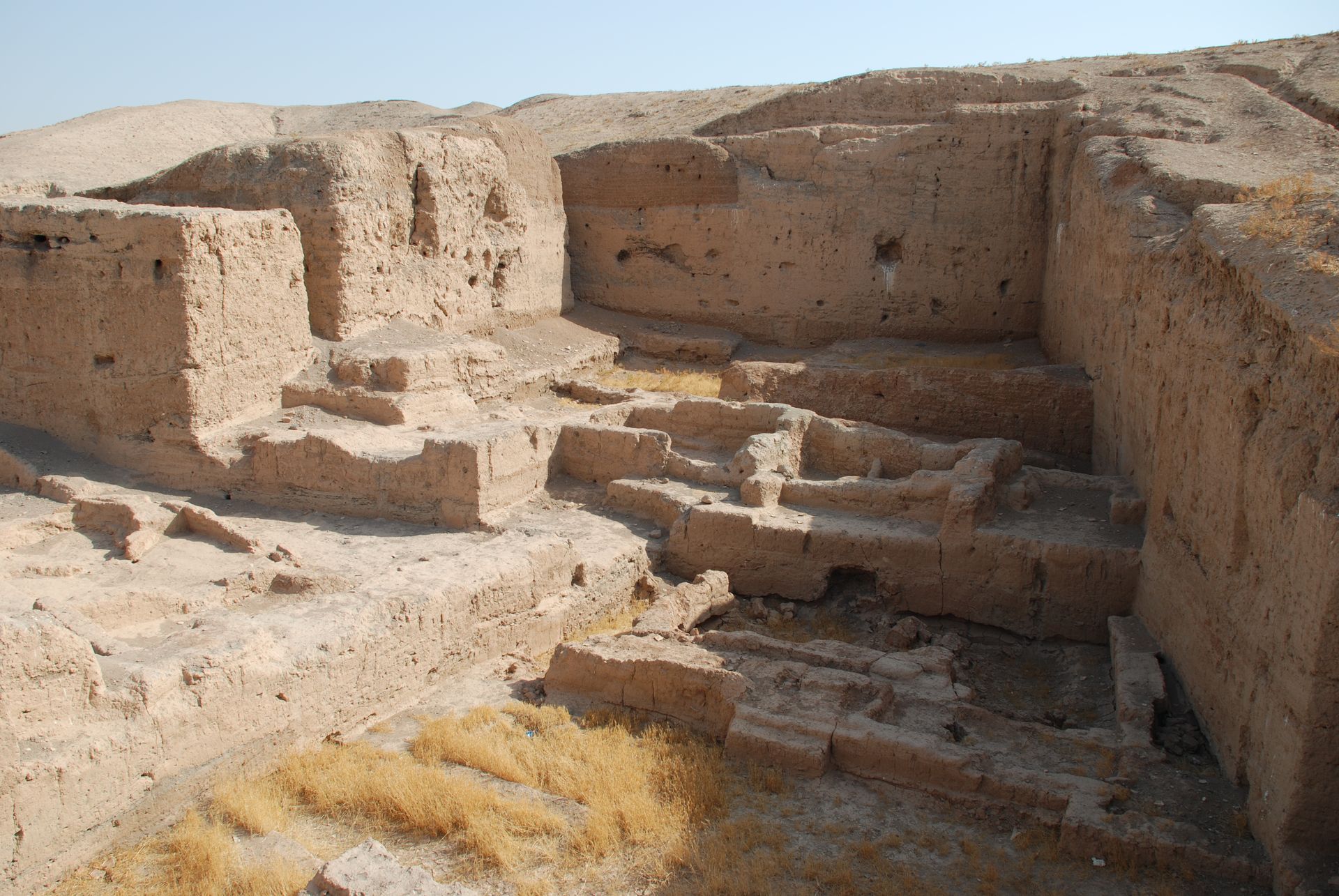
Toponym Sumer has derived from Acadian word Sumeru which in its turn is a Sanskrit loan word. The Sumerian inscriptions inform that their-cities, like Kish, Lagash Larsa, Erek, Umma, Nippurand Ura were founded and settled after the deluge. Nagar was the name of one of the outpost of a Sumer city (Present Tel Brak in northern Mesopotamia). This was one of the earliest occupied sites inhabited since 6000 BCE up to the second milleniu BCE. There is a reference to Ura even in the Purans. These city states fought among themselves and sometimes allied against one another or against some external enemy. During the third millennium BCE, a close cultural symbiosis developed between the Sumerians (who spoke a common language) and the Semitic Acadian speakers, which included widespread bilingualism. They developed a great culture. These people established large and prosperous cities and built great temples and grand mansions. They created beautiful idols of gods amd goddesses. Advanced system of irrigation was developed and there was great growth of agriculture in the fertile valleys of Dajala and Furat. Trade and industry also thrived.
These were the original nascent Republics of Sumer. People of these states remembered the ancient tradition of the Republic of Bharata. There was a Parliament in each city, representatives of the people. It had two houses (similar to Sabha and Samiti of Rig-Veda). One house represented the senior citizens, while the second house consisted of experts in various branches of governance. The system of government was quite similar to the one that depicted in the Rig-Veda where Sabha and Samiti were said to be the daughters of Brahma :
Sabhaache mam samitischavatam prajapaterduhitaro samvidhane |
सभाच मां समितिश्चवतां प्रजापतेर्दुहितरौ संविधाने |
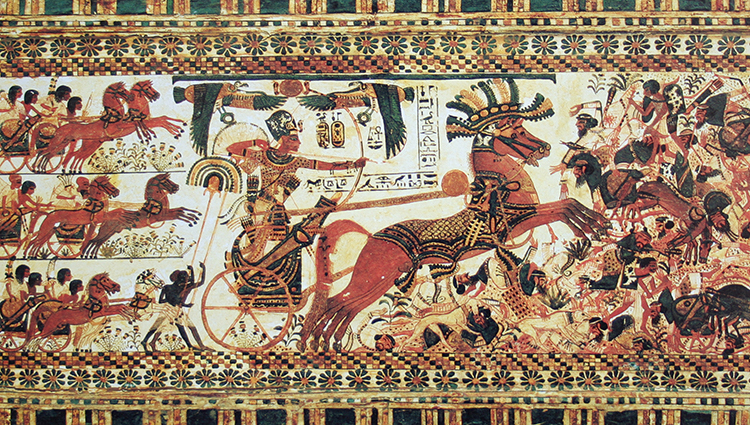 Ra was the ruler of the heavens who heralded light. He was patron of the light pharaohs. According to popular belief, the Ra drove his chariot through the heavens which caused cycle of the day and night. Hathor was a pre-dynastic goddess who embodied femininity, love and joy of motherhood. In the ancient Egyptian religion, Geb was the god of the earth and was the first king of Egypt. He was often portrayed lying beneath the sky goddess. There was another God Ptat (vocalized as Pitah in Egypt). Ptah was the creator god. He was responsible for the fashioning and maintenance of the physical universe. He was thought to have existed before all things, and gave birth to the universe just by wishing. He was their great Father, (Prajapita Brahma). There were gods representing the Earth and sky. Every village had its own protective deity. According to ancient literature of Egypt Thotha imparted knowledge to man 20000 years ago. He was supposed to have ruled over this earth for over 3000 years and written over 36000 works. Heleopolis means the city of the Sun, which was the center of the culture of Egypt. The Gods and Goddesses of ancient Egypt were a complex group of beings ideas. As the culture evolved, so did many of the deities and what they represented. During the new Kingdom, the cult of the sun god Ra became increasingly important until it evolved into the uncompromising monotheism of Pharaoh Akhenaton (Amenhotep IV, 1364-1347 BCE). According to the cult, Ra created himself from a primeval mound in the shape of a pyramid and then created all other gods. Thus Ra was not only the sun God he was also the universe, having created himself from himself (Swayanbhu). Ra was invoked as Aton or the Great Disc with each ray or sunbeam ending in a ministering hand that illuminated the world of the diving and the dead. The effect of these doctrines can be seen in the sun worship of Pharaoh Akhenaton, who became an uncompromising monotheist.
Ra was the ruler of the heavens who heralded light. He was patron of the light pharaohs. According to popular belief, the Ra drove his chariot through the heavens which caused cycle of the day and night. Hathor was a pre-dynastic goddess who embodied femininity, love and joy of motherhood. In the ancient Egyptian religion, Geb was the god of the earth and was the first king of Egypt. He was often portrayed lying beneath the sky goddess. There was another God Ptat (vocalized as Pitah in Egypt). Ptah was the creator god. He was responsible for the fashioning and maintenance of the physical universe. He was thought to have existed before all things, and gave birth to the universe just by wishing. He was their great Father, (Prajapita Brahma). There were gods representing the Earth and sky. Every village had its own protective deity. According to ancient literature of Egypt Thotha imparted knowledge to man 20000 years ago. He was supposed to have ruled over this earth for over 3000 years and written over 36000 works. Heleopolis means the city of the Sun, which was the center of the culture of Egypt. The Gods and Goddesses of ancient Egypt were a complex group of beings ideas. As the culture evolved, so did many of the deities and what they represented. During the new Kingdom, the cult of the sun god Ra became increasingly important until it evolved into the uncompromising monotheism of Pharaoh Akhenaton (Amenhotep IV, 1364-1347 BCE). According to the cult, Ra created himself from a primeval mound in the shape of a pyramid and then created all other gods. Thus Ra was not only the sun God he was also the universe, having created himself from himself (Swayanbhu). Ra was invoked as Aton or the Great Disc with each ray or sunbeam ending in a ministering hand that illuminated the world of the diving and the dead. The effect of these doctrines can be seen in the sun worship of Pharaoh Akhenaton, who became an uncompromising monotheist.
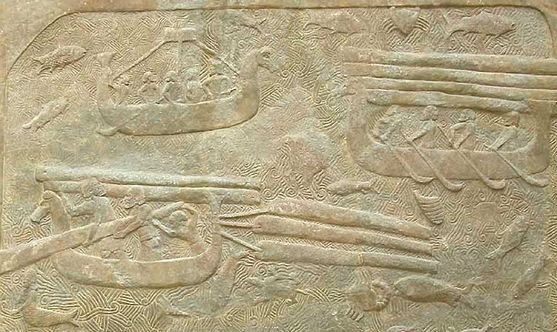 The history and culture of Phoenicians remind us of the people frequently mentioned in Rig-Veda as ‘Pani’. The word Panik (in Sanskrit) means merchant who deals with ‘Panan’ (trade) in Panya (market). Panis were merchants par excellence in Rig-Vedic age. In Sanskrit ‘Pana’ and ‘Vana’ both the words are used for water and Panik as well as Vanik are the words used for merchants. As the Pains used the sea routes for their farfetched trade they were called ‘Panik’. The ‘Pani’ might have been the Bharatiya traders who spread Bharatiya culture to the west.
The history and culture of Phoenicians remind us of the people frequently mentioned in Rig-Veda as ‘Pani’. The word Panik (in Sanskrit) means merchant who deals with ‘Panan’ (trade) in Panya (market). Panis were merchants par excellence in Rig-Vedic age. In Sanskrit ‘Pana’ and ‘Vana’ both the words are used for water and Panik as well as Vanik are the words used for merchants. As the Pains used the sea routes for their farfetched trade they were called ‘Panik’. The ‘Pani’ might have been the Bharatiya traders who spread Bharatiya culture to the west.
According to tradition the Panis lived in fortified towns surrounded by motes supplied by water from the adjoining river. They lived in large palatial houses and led a luxurious life. Their wealth included cattle, cows, horses and other animals and also the warehouses full of marketable goods brought from various places. They possessed gold, diamonds, pearls, and precious stones in large quantities. They were fond of precious ornaments and jewelry.
They were skillful mariners as well as ship builders. They were adventurous sea farers. They probably explored the sea routes of the Arabian Sea and Persian Gulf as also the Mediterranean Sea. They were also skilled agriculturist. They constructed dams and canals for purposes of irrigation. There is such a similarity between the marine culture of the Phoenicians and the Panis that they could be taken to be identical.
Europe and Africa
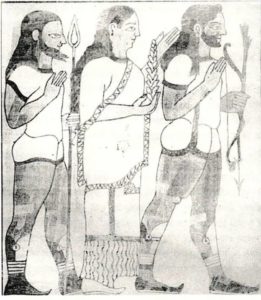
Etruscan civilization is the modern English name given to a civilization of ancient Italy in the region corresponding roughly to Tuscany, western Umbria, and northern Latium. The ancient Romans called the Etruscans the Tusci or Etrusci. Name of the province of Tuscany has come from Tusci. Etruscan culture developed in Italy after about 800 BCE. The Etruscans held sway in Italy up to 500 BCE. Their culture influenced the Roman culture profoundly. Many pictures of the various incidents in the Ramayana have been found in Italy, particularly in Taraquinuya and Cerveteri, on the walls, on flower pots and on mirrors of bronze. It is astounding that stories of Ramayana had travelled to far away Europe 2800 years ago. In fact Bharatiya settlements were already there in central and west Asia long before. This has been described in the previous chapter how the ancient cultures of Iran, Iraq and Anatolia were influenced by the culture of Bharata. Once Bharatiya influence had reached the shores of the Mediterranean, Italy could not be out of their reach.
The Etruscans seem to have come to Italy through sea routes from Asia minor. Minonius, the founder of the Lydians, defeated the Phrygians and established Lydian dynasty in Asia minor. Lydians worshipped the Sun God and the Lord Shiva. They worshiped at the temple every day. The Lydians are said to have migrated to the western coast of Italy. According to a story cause of this mass exodus could be famine. The Lydian king is said to have divided his people in two groups and through lottery one of the groups migrated from the country. The Etruscans are thought to be the progeny of these migrants. The Etruscans were greatly influenced by the Bharatiya culture. Shivalinga in the Etuscan museum in the Vatican provides reliable proof of Bharatia connection of the Etruscans. The renowned novelist, poet and playwright DH Lawrence found large number of Shivlingas during his journey in north Italy at the entrance of innumerable Cerverety tombs in 1927 CE.
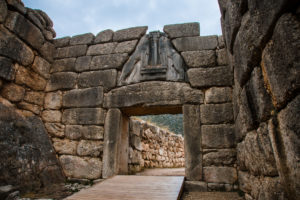 The civilization of Crete has been given the name after legendary King Minos (a variant of Manu) of Knossos, which was the chief city of the island throughout early times. After Manu, the celebrated legendry first king of Bharata, are to be found the titles of founder of dynasties of Egypt (Menes), Phyrgia, Lydia (Meon) and Cannan (Baal Meon). The civilization that arose on the mainland under Cretan influence in Yuhabd 15th century (16th century BCE) is called Mycenaean Mycenae, which appears to have been one of its most important centers. Minos became the title of the Minoan kings after the founder of dynasty. Name of the island was pronounced Kriti by the ancient Greek people. The island has an elongated shape. It spans 260 km from east to west, is 60 km at its widest point and narrows to as little as 12 km. Crete has an area of 8,336 km, with a coastline pf 1,046 km. To the north, of it is the Sea of Crete; to the south, the Libyan Sea; in the west, the Myrtoan Sea, and towards the east the Carpathian Sea. It lay approximately 160 km south of the Greek mainland and 256 kms to the north of the African coast. The ancient City of Troy in western Anatolia is about 500 kms away from Crete.
The civilization of Crete has been given the name after legendary King Minos (a variant of Manu) of Knossos, which was the chief city of the island throughout early times. After Manu, the celebrated legendry first king of Bharata, are to be found the titles of founder of dynasties of Egypt (Menes), Phyrgia, Lydia (Meon) and Cannan (Baal Meon). The civilization that arose on the mainland under Cretan influence in Yuhabd 15th century (16th century BCE) is called Mycenaean Mycenae, which appears to have been one of its most important centers. Minos became the title of the Minoan kings after the founder of dynasty. Name of the island was pronounced Kriti by the ancient Greek people. The island has an elongated shape. It spans 260 km from east to west, is 60 km at its widest point and narrows to as little as 12 km. Crete has an area of 8,336 km, with a coastline pf 1,046 km. To the north, of it is the Sea of Crete; to the south, the Libyan Sea; in the west, the Myrtoan Sea, and towards the east the Carpathian Sea. It lay approximately 160 km south of the Greek mainland and 256 kms to the north of the African coast. The ancient City of Troy in western Anatolia is about 500 kms away from Crete.
 The Nile is a Sanskrit name. The river has two branches. One is called the White Nile, while the other is called Blue Nile. The river Nile takes its birth from the Lake Victoria (Amara Sarovara). It flows northward for over 7000 kms, and flows into the Mediterranean Sea in the north. John Speaky was the European traveler who discovered the source of the river Nile. He wrote and published a romantic book, in Kaliyugabda 4965 (1863CE) based on the story of the discovery of the source of the river Nile. The book was called “The discovery of the source of the River Nile.” He has stated that he succeeded in his discovery because of a map in the Puranas of Bharat showing Africa. Col. Winfred of British Indian army had given him this map. Col Winfred had prepared this map with the help of a Hindu Scholar in Calcutta. Speaky has reproduced this map in his book. J.H. Speaky together with J.A. Grant achieved the rare distinction of having discovered the source of Nile. He confesses that while on the historic expedition on the nineteen century, one Colonel Rigby had given to him a paper with a map attached to it about the Nile and the Mountains of the Moon and the paper, in turn had been copied by Lieutenant Wilford from the Puranas of the ancient Hindus. That paper appears to have proved to be of great assistance to him in achieving his mission. (Quoted from ‘Journal of Discovery of the ‘Source of Nile’, by Salvodri Cynthia, op cit Vol. II. 1996. P. 84’)
The Nile is a Sanskrit name. The river has two branches. One is called the White Nile, while the other is called Blue Nile. The river Nile takes its birth from the Lake Victoria (Amara Sarovara). It flows northward for over 7000 kms, and flows into the Mediterranean Sea in the north. John Speaky was the European traveler who discovered the source of the river Nile. He wrote and published a romantic book, in Kaliyugabda 4965 (1863CE) based on the story of the discovery of the source of the river Nile. The book was called “The discovery of the source of the River Nile.” He has stated that he succeeded in his discovery because of a map in the Puranas of Bharat showing Africa. Col. Winfred of British Indian army had given him this map. Col Winfred had prepared this map with the help of a Hindu Scholar in Calcutta. Speaky has reproduced this map in his book. J.H. Speaky together with J.A. Grant achieved the rare distinction of having discovered the source of Nile. He confesses that while on the historic expedition on the nineteen century, one Colonel Rigby had given to him a paper with a map attached to it about the Nile and the Mountains of the Moon and the paper, in turn had been copied by Lieutenant Wilford from the Puranas of the ancient Hindus. That paper appears to have proved to be of great assistance to him in achieving his mission. (Quoted from ‘Journal of Discovery of the ‘Source of Nile’, by Salvodri Cynthia, op cit Vol. II. 1996. P. 84’)
America
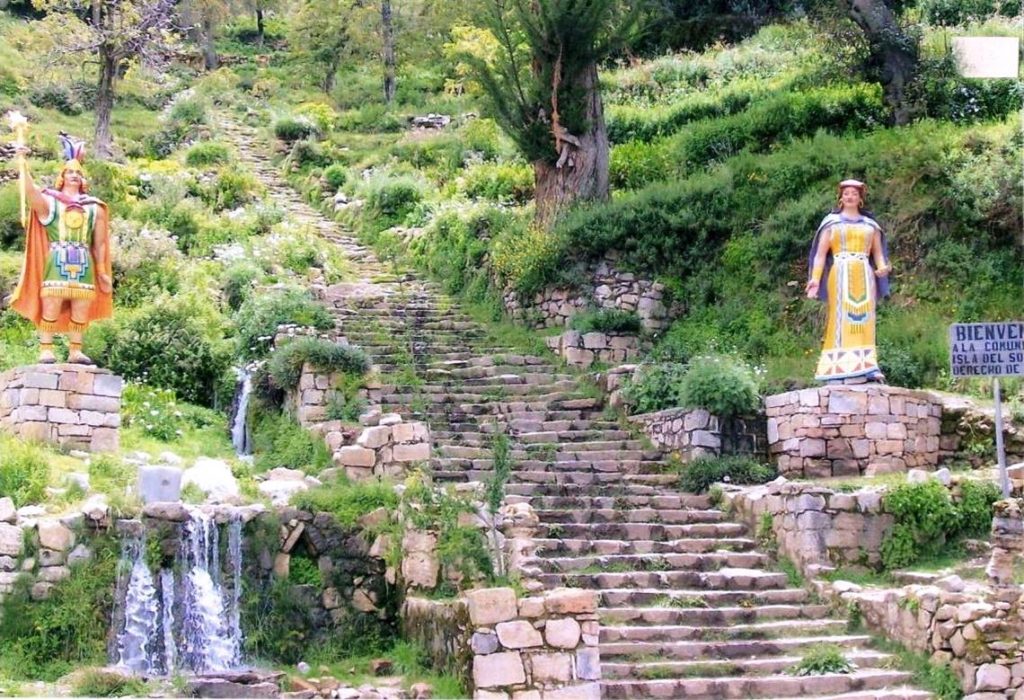 In the heterogeneous Inca Empire several polytheistic religions were practiced by its different people. Most religions had common traits such as the existence of Pachamama and Viracocha, The Incas controlled religion to give the empire cohesion by having conquered people and the Inca deities to their pantheon. Just as in Vedic religion, Inca deities occupied the three realms: Hanas Pacha, the celestial realm in the sky; uku Pacha, the inner earth realm; and Cay Pacha, the outer Earth realm, where humans live. Uku Pacha was the domain of Pachamama, the Earth Mother, the first God, creator of the three realms and their inhabitants, was also the consort of father of Inti. Many ancient Andean people traced their origins to ancestral deities. Multiple ayllus (communities) could share identical ancestral origins. The Inca claimed descent from the Sun and the Moon, their Father and Mother (compare Surya and Chandra Vamsha in Bharata.) The earliest amcestors of the Inca were known as Ayar (Arya), the first of which was Manco Capac or Ayar Manco. Religious tradition in the Andes tended to vary among different ayllus. While the Inca generally allowed or even incorporated local deities and heroes of the ayllus they conquered. One example of this is Pachamama, the goddess of mother earth, who was worshiped long before the rise of the Inca. Pachmama having been integrated in the Inca pantheon was placed below the Moon. The Moon was named Mamaquilla (Mother Moon) there was Pachmama (Mother Earth. Earth was regarded mother in Atharva Veda also), the Mamasara (Corn Goddess), Mamaqocha (the Mother ocean).
In the heterogeneous Inca Empire several polytheistic religions were practiced by its different people. Most religions had common traits such as the existence of Pachamama and Viracocha, The Incas controlled religion to give the empire cohesion by having conquered people and the Inca deities to their pantheon. Just as in Vedic religion, Inca deities occupied the three realms: Hanas Pacha, the celestial realm in the sky; uku Pacha, the inner earth realm; and Cay Pacha, the outer Earth realm, where humans live. Uku Pacha was the domain of Pachamama, the Earth Mother, the first God, creator of the three realms and their inhabitants, was also the consort of father of Inti. Many ancient Andean people traced their origins to ancestral deities. Multiple ayllus (communities) could share identical ancestral origins. The Inca claimed descent from the Sun and the Moon, their Father and Mother (compare Surya and Chandra Vamsha in Bharata.) The earliest amcestors of the Inca were known as Ayar (Arya), the first of which was Manco Capac or Ayar Manco. Religious tradition in the Andes tended to vary among different ayllus. While the Inca generally allowed or even incorporated local deities and heroes of the ayllus they conquered. One example of this is Pachamama, the goddess of mother earth, who was worshiped long before the rise of the Inca. Pachmama having been integrated in the Inca pantheon was placed below the Moon. The Moon was named Mamaquilla (Mother Moon) there was Pachmama (Mother Earth. Earth was regarded mother in Atharva Veda also), the Mamasara (Corn Goddess), Mamaqocha (the Mother ocean).
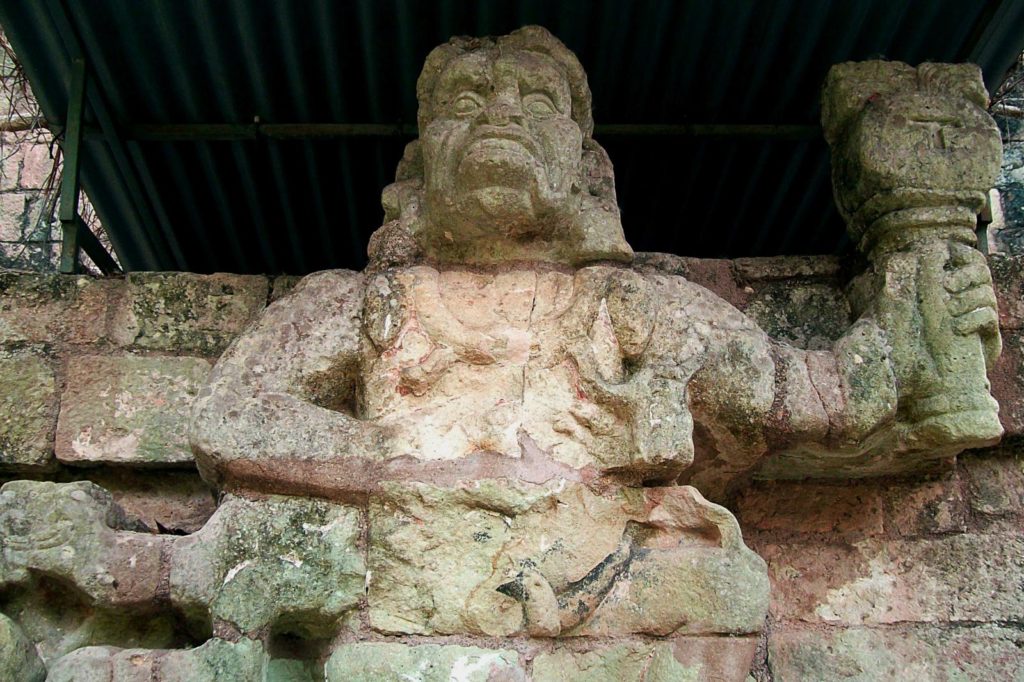 The adventurous merchants, sailors and preachers (the Bhikkus and sanyasis) must have crossed the Pacific Ocean to reach Mesoamerica. When did this happen? The calendar of the Mayan civilization began in Kaliyugabda 2489 (613 BCE). This could well be a significant year of their history.
The adventurous merchants, sailors and preachers (the Bhikkus and sanyasis) must have crossed the Pacific Ocean to reach Mesoamerica. When did this happen? The calendar of the Mayan civilization began in Kaliyugabda 2489 (613 BCE). This could well be a significant year of their history.
Mayan pyramid temple began to be constructed after about 28 century of Kaliyugabda (300 BCE). Such colossal structures continued to be constructed till about 43 century of kaliyugabda (1200 CE). This was the period when Maya civilization flourished. This is also the period when civilization of Bharata was ascendant and its people had not ceased to reach out to spread the message of Bharatiya culture all over the world.
The Brahmi inscription of Mahaanavika Buddhagupta of 35th century of Kaliyugabda (5th century CE) found in Malaysia and that of Mahanavika Vasuluna of 41st century of Kaliyugabda (10th CE) found in Mexico bear testimony to the maritime contact of Bharata with the Southeast Asian islands and Mesoamerica.